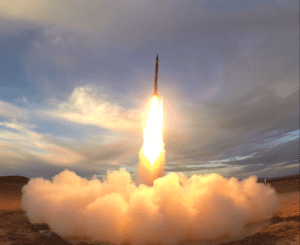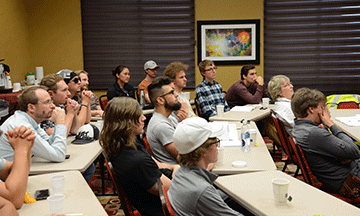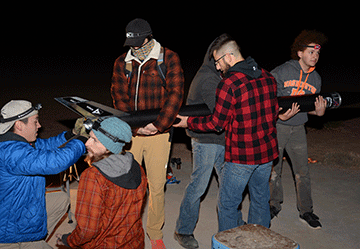
#RocketScience: NMT Rocketry Team Launches Mustang 6A From Spaceport America

New Mexico Tech’s Student Rocket Design Team launched the first Mustang rocket from Spaceport America. The launch of the Mustang, the largest rocket ever attempted by NMT’s program, culminated 15 months of design and construction work for the team.
The rocketry team developed the Mustang 6A in collaboration with White Sands Research and Developers, LLC (http://www.wsrds.com), an aerospace company based in Las Cruces. Tech’s Mechanical Engineering department chair, Dr. Andrei Zagrai, had long realized that the relationship between academia and industry has the highest potential to advance the NMT rocketry program.
“WSRD and NMT have been nurturing just such a relationship for five years and through three launches,” Zagrai said. “The Mustang rocket was born thanks to this partnership.”
Dan Hicks, CEO of Spaceport America, said, “We are proud of the New Mexico Tech team and its student members for their recent launch effort on November 4 at Spaceport America. We are pleased to work with these fine examples of the next generation of space industry engineers and scientists.”
Design of the Mustang’s outer mold line (OML), or its external shape, began in WSRD’s laboratory in the summer of 2016. The primary design goal was to develop an OML with a roomy payload section that could be scaled geometrically in sizes ranging from 2- to 18-inch in diameter and would be dynamically stable at speeds from low subsonic to Mach 6.
 This year’s team leads are Aaron Misla and Connor Deuschle and last year’s team leads
were Joachim Lohn-Jaramillo and Gabriel Montoya. Rocket team members over the past
three semesters include Edgar Adomson, Joshua Berson, Mitchell Ching, Luis Cuenca,
Ryan Garcia, Tanner Graham, Dylan Johnston, Francisco Koerdell-Sanchez, James Nolan,
Dylan Purcell, James Ritter, Alejandro Rodriguez, John Sanchez, Nico Seamons, Wesley
Small, Andrew Wanchek, and sophomore volunteer Calla Lang.
This year’s team leads are Aaron Misla and Connor Deuschle and last year’s team leads
were Joachim Lohn-Jaramillo and Gabriel Montoya. Rocket team members over the past
three semesters include Edgar Adomson, Joshua Berson, Mitchell Ching, Luis Cuenca,
Ryan Garcia, Tanner Graham, Dylan Johnston, Francisco Koerdell-Sanchez, James Nolan,
Dylan Purcell, James Ritter, Alejandro Rodriguez, John Sanchez, Nico Seamons, Wesley
Small, Andrew Wanchek, and sophomore volunteer Calla Lang.
When the fall 2016 semester started, Dr. Paul T. Jaramillo of WSRD presented the Mustang to the NMT Rocket Team as a design methodology that could eventually make it all the way to space. The first step would be fabrication of the six-inch diameter, 10-foot tall version of the Mustang, which would be the largest rocket ever attempted by NMT’s rocket program. The Mechanical Engineering faculty also saw the Mustang as a path to enhance NMT research opportunities with a platform capable of hosting cutting-edge research. Subsystem designs began in earnest in the fall of 2016. It culminated in this latest successful launch.
While both of the previous two launches received high praised from the New Mexico Spaceport Authority (NMSA), this team reached new levels of safety, proficiency, adherence to schedule, and professionalism throughout the launch process.
 The team arrived on site at 3 a.m. and immediately began assembling the rocket and
mounting it on the launch pad. The launch occurred at 7:35 a.m., following a four-minute
delay to wait for a break in the cloud cover.
The team arrived on site at 3 a.m. and immediately began assembling the rocket and
mounting it on the launch pad. The launch occurred at 7:35 a.m., following a four-minute
delay to wait for a break in the cloud cover.
“This mission took enormous preparation by WSRD’s launch crew and the NMT rocket team,” Dr. Christina Lohn, WSRD’s CEO said. “But it really paid off with a smooth operation under changing weather conditions.”
Despite a textbook ignition and clean bright plume, the Mustang did not reach its intended apogee of 24,000 feet. However, the number of objectives achieved was astonishing. Early analysis indicates that every subsystem designed and built by the students performed nominally, including recovery of the payload bay, which was intact.
Subsystems included several innovative elements including a non-pyrotechnic separation system and a non-pyrotechnic main parachute recovery system
Lohn presented the team members and faculty advisor Dr. Michael Hargather with a mission patch commemorating the Mustang 6A inaugural mission. Dr. Julie Ford, Chris Langley, and Jim Ruff comprise the rest of the faculty members advising the team.